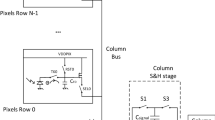Abstract
A time error correction method for improving the accuracy of asynchronous CMOS (Complementary Metal Oxide Semiconductor) imager sensor (CIS) is proposed. By adding a time error measurement unit in each pixel, the time error can be recorded, and then is sent out together with the address-events. Besides, in the external processing circuit, the correction will be accomplished before making time-stamping. For the sake of clarifying the influences on the image accuracy, different scale of the pixel array, event collisions, accuracy of time-stamping and illumination are adopted in the simulation. The simulation results of the Matlab Simulink show that, in an 8 × 8 asynchronous CIS without time error correction, when the illumination is 103 ~ 105 lx, the error of the image accuracy is from 0.4 % to 28 %. With the decrease of the time-stamping accuracy, the expansion of pixel array, the increase of event collisions and the strengthening of illumination, the error would deteriorate further. As to the model of asynchronous CIS with time error correction, when the accuracy of the time-stamping is 10 ns, the time error can be controlled within 20 ns. For the same illumination, the maximal error of image is 0.31 %.













Similar content being viewed by others
References
Theuwissen, A. J. P. (2000). CMOS image sensors: state-of- the-art. Solid State Electronics, 52(9), 1401–1406.
Delbruck, T. (2008). Frame-free dynamic digital vision. Advanced Electronics for Quality Life and Society, 6(3), 21–26.
Litzenberger, M., Kohn, B., Gritsch, G. (2007). Vehicle Counting with an Embedded Traffic Data System using an Optical Transient Sensor. IEEE Intelligent Transportation Systems Conference, Seattle, WA, September 30–October 3 2007, (pp. 36–40).
Drazen, D., Lichtsteiner, P., Hafliger, P., et al. (2011). Toward real-time particle tracking using an event-based dynamic vision sensor. Experiments in Fluids, 51(5), 1465–1469.
Culurciello, E., Etienne-Cummings, R., & Boahen, K. A. (2003). A biomorphic digital image sensor. IEEE Journal of Soild-State Circuits, 38(2), 281–294.
Maher, M. A. C., Deweerth, S. P., Mahowald, M. A., & Mead, C. A. (1989). Implementing neural architectures using analog VLSI circuits. IEEE Transactions on Circuits System, 36(5), 643–652.
Mahowald, M. A. & Mead, C. A. (1991). The silicon retina. Scientific American (International Edition) 264,(5) 76–82.
Delbruck, T., Linares-Barranco, B., Culurciello, E. et al. (2010). Activity-Driven, Event-Based Vision Sensors. IEEE International Symposium on Circuits and Systems, Paris, May 30–June 2 2010, (pp. 2426–2429).
Lichtsteiner, P., Posch, C., Delbruck, T. (2006). A 128 × 128 120dB 30mW Asynchronous Vision Sensor that Responds to Relative Intensity Change. International Solid-State Circuits Conference, San Francisco, CA, February 6–9 2006, (pp. 2060--2069).
Lichtsteiner, P., Posch, C., & Delbruck, T. (2008). A 128 × 128 120 dB 15 US latency asynchronous temporal contrast vision sensor. IEEE Journal of Solid-State Circuits, 43(2), 566–576.
Leñero-Bardallo, J. A., Serrano-Gotarredona, T., & Linares-Barranco, B. (2011). A 3.6 US latency asynchronous frame-free event-driven dynamic vision sensor. IEEE Journal of Solid-State Circuits, 46(6), 1443–1455.
Shoushun, C., & Bermak, A. (2005). A low power CMOS imager based on time-to-first-spike encoding and fair AER. IEEE International Symposium on Circuits and Systems, ISCAS 2005, Kobe, Japan, May 23–26 2005, (pp. 5306–5309).
Guo, X., Qi, X., & Harris, J. G. (2007). A time-to-first-spike CMOS image sensor. IEEE Sensors Journal, 7(8), 1165–1175.
Matolin, D., Wohlgenannt, R., Litzenberger, M., Posch, C. (2010). A Load Balancing Readout Method for Large Event-Based PWM Imaging Arrays. Proceedings of 2010 IEEE International Symposium on Circuits and Systems, Paris, May 30–June 2 2010, (pp. 361–364).
Posch, C., Matolin, D., & Wohlgenannt, R. (2011). A QVGA 143 dB dynamic range frame-free PWM image sensor with lossless pixel-level video compression and time-domain CDS. IEEE Journal of Solid-State Circuits, 46(1), 259–275.
Hofstätter, M., Schön, P., Posch, C. (2009). An integrated 20-bit 335M events AER sensor interface with 10 ns time-stamping and hardware-accelerated event pre-processing. IEEE Biomedical Circuits and Systems Conference, Beijing, November 26–28 2009, (pp. 257–260).
Acknowledgments
This work is supported by National Natural Science Foundation of China (NFSC) Under Grant (No. 61274021,61234003).
Author information
Authors and Affiliations
Corresponding author
Rights and permissions
About this article
Cite this article
Xu, J., Li, D. & Yao, S. A Time Error Correction Method Applied to High-Precision AER Asynchronous CMOS Image Sensor. J Sign Process Syst 75, 1–13 (2014). https://doi.org/10.1007/s11265-013-0800-0
Received:
Accepted:
Published:
Issue Date:
DOI: https://doi.org/10.1007/s11265-013-0800-0




